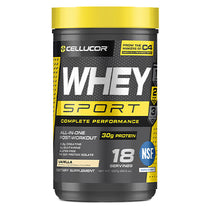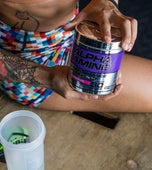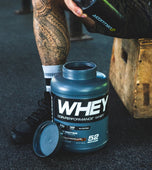You’ve probably felt the dreaded “afternoon slump,” the dip in energy that occurs for many people around 1-3pm. During an afternoon slump it may feel like your brain is in quicksand, and all productivity comes dragging to a halt. Finding the necessary drive to focus on tasks becomes difficult. It’s at this point where most people turn to a caffeinated beverage whether it be coffee, green tea, or an energy drink to help pull them out of their slump.
While coffee and green tea have historically been two of the most popular caffeinated drinks on the planet, they can be bitter or astringent at times. This is partly why energy drinks have become so popular as they can provide a caffeinated boost in refreshing and even fruity flavors. Unfortunately, many energy drinks are high in sugar, which may not be good for your health and may not be the kind of “crash and burn” energy you are looking for.
Energy Drink Ingredients
The International Society of Sports Nutrition published a position stand on energy drinks where they came to a few conclusions: 1) Energy drink consumption before exercise can improve mental focus, alertness, and endurance; 2) Energy drink consumption among healthy populations is safe and similar to ingesting caffeine from other drink or food sources; 3) Athletes should consider the metabolic impacts of consuming high glycemic load carbohydrates (common in many energy drinks).[1] While energy drinks have traditionally been associated with high sugar and strange stimulants, C4® Energy is making people rethink energy drinks, by delivering formulas designed to enhance mental performance without the compromise of traditional energy drinks. Here are some key features to look for to make informed energy drink choices in pursuit of a healthier alternative to the high-sugar options.

Caffeine: Know Your Limits
Caffeine is the primary ingredient responsible for the stimulating effect of energy drinks. Low (40 mg) to somewhat high (300 mg) doses of caffeine are associated with increased alertness, vigilance, and reaction time.[2] The FDA’s upper limit for daily caffeine consumption in healthy adults is 400 mg/day. The caffeine amount in energy drinks typically ranges between 70 – 200 mg per serving.[3] However, a somewhat deceptive tactic that some companies use is to include multiple servings in one container, which can lead you to consume twice the amount of caffeine than you had intended, if you aren’t paying close attention. Most caffeine used in energy drinks is derived from caffeine anhydrous, a synthetic form of caffeine. Many energy drinks will also include ingredients like green tea, guarana, and yerba mate which have naturally occurring caffeine, however these generic herbal ingredients are typically not standardized for caffeine, so the caffeine content may vary batch to batch. This variation with naturally occurring caffeine sources is common, in one study researchers purchasing the same coffee beverage from the same shop for a week reportedly found the caffeine content to vary between 259 –564 mg/dose.[4] C4 ® Smart Energy uses InnovaTea®, a naturally-derived form of caffeine, that’s standardized from green tea, and is laboratory tested for quality and potency.
Tip: Make sure you’re paying attention to the caffeine content of the energy drinks you consume and not exceeding 400 mg of caffeine in a day.
Sugars and Sweeteners: How Much and What Types?
Energy drinks have traditionally relied on sugar as one of the main ingredients delivering “energy” in their formula. Companies will often list sugar in a variety of ways including as dextrose, cane sugar, and fruit juice concentrate. On average, energy drinks contain about 54 grams of added sugar per serving — that’s 216 calories.[5] This is well above the American Heart Association’s daily upper intake limit of 25-36 grams for added sugars.[6] Excess sugar consumption has traditionally been associated with poor health outcomes.[7] As a result, some companies offer naturally and artificially sweetened versions of energy drinks as alternatives to their more popular sugar sweetened versions. Some of the most common alternative sweeteners include sugar alcohols, artificial sweeteners, and stevia (a plant-based sweetener). Research on different sugar alcohols has found many of them to be associated with upset stomachs.[8] For all C4® Energy drinks, we use a formula that’s zero sugar and zero sugar alcohols.
Tip: When picking an energy drink, be sure to look at the sugar content. If the company uses alternative sweeteners instead of sugar, be sure to check what type of sweetener is being used.

Functional Ingredients: Can energy drinks boost sports performance?
Functional ingredients are those included in a formula to help support a desired benefit. Caffeine, amino acids, and adaptogens have traditionally been some of the most popular types of functional ingredients used in energy drink formulas.
Tip: If you’re picking an energy drink to boost physical performance, make sure it includes well researched ingredients that have been tested in clinical trials.
Summary
While there has been a stigma attached to energy drinks, options now exist so that you can make more informed energy drink choices. The entire C4® Energy family of drinks is dedicated to delivering performance without compromising on taste or calories. C4® Smart Energy offers a naturally sourced form of caffeine. And C4® Ultimate is an energy drink designed for the ultimate energy experience. The next time you feel an afternoon slump creeping in, you can finally rethink energy drinks and charge ahead with your goals.
References
[1] https://jissn.biomedcentral.com/articles/10.1186/1550-2783-10-1
[2] https://www.sciencedirect.com/science/article/pii/S0149763416300690
[3] https://www.ncbi.nlm.nih.gov/pmc/articles/PMC2966367/
[4] https://academic.oup.com/jat/article/27/7/520/784168
[5] https://www.ncbi.nlm.nih.gov/pmc/articles/PMC2966367/
[6] https://ww.ahajournals.org/doi/pdf/10.1161/circulationaha.109.192627
[7] https://www.ncbi.nlm.nih.gov/pmc/articles/PMC5093271/
[8] https://pubmed.ncbi.nlm.nih.gov/31246081/











